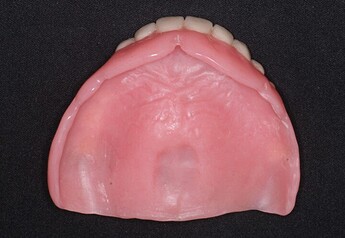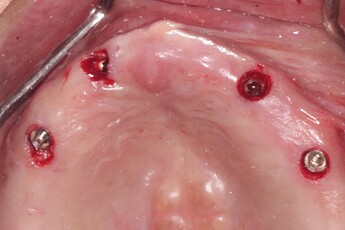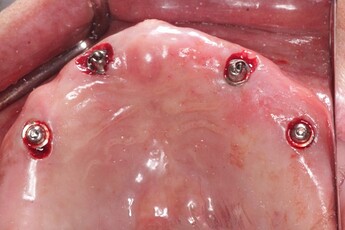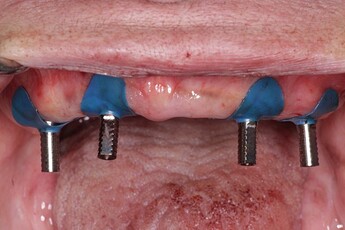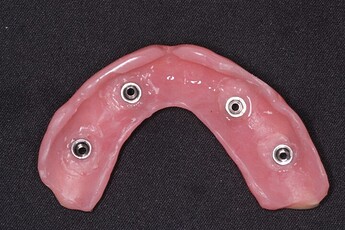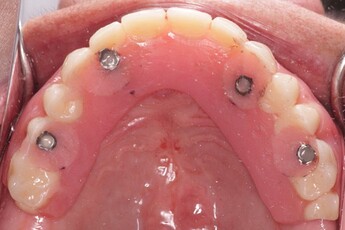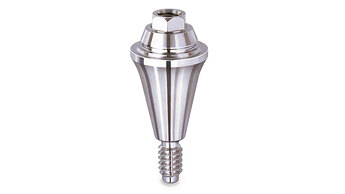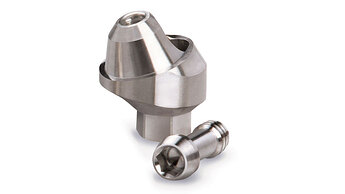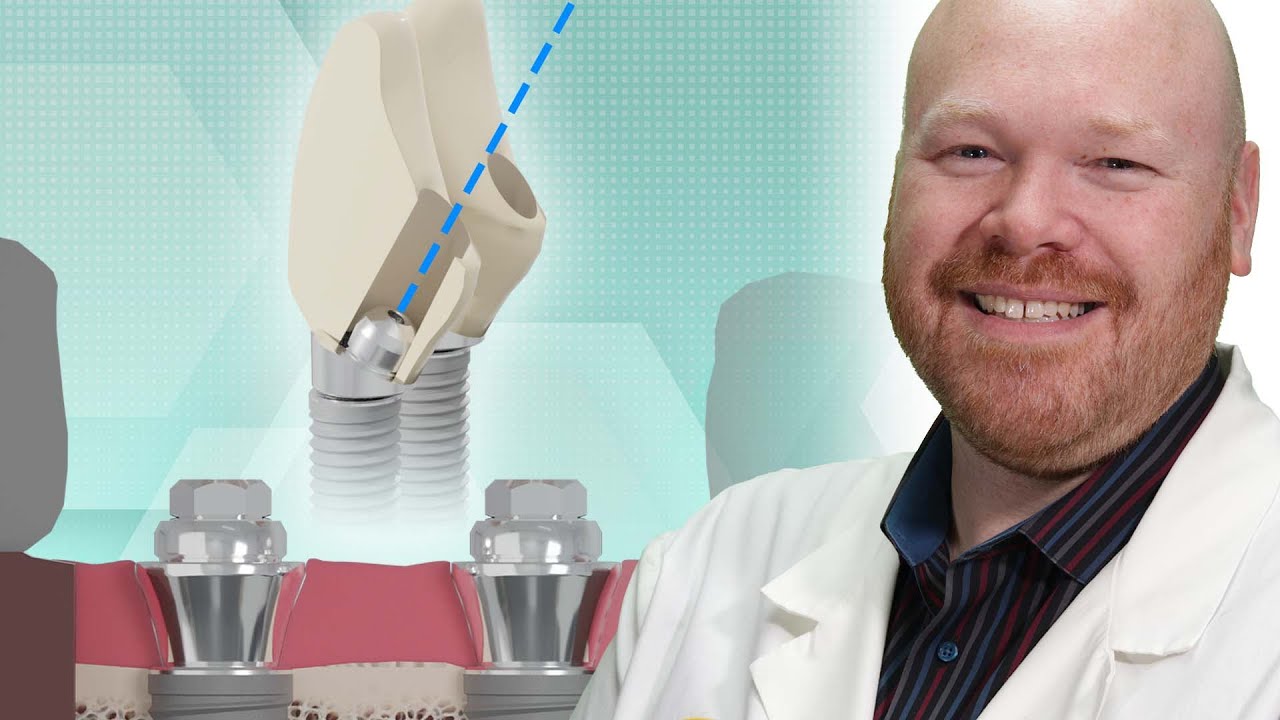This Week in Dental Implants, we are presenting a case from Dr. Daniel Gober utilizing multi-unit abutments for a denture conversion.
Background
Multi-unit abutments, both straight and angled, were introduced with the advent of the All-on-4 technique, where implants are placed at various angles and heights. Developed by Dr. Malo, the All-On-4 procedure, was aimed at avoiding expensive and regenerative procedures, and allowing for immediate function of a fixed prosthesis, by maximizing the use of available bone. 1,2 There are numerous advantages to the procedure and many studies have supported its effectiveness. 3,4,5 Multi-unit abutments, which support different angulations and heights, are therefore required for these type of All-On-X procedures.
Of course, there are many factors to consider when choosing between a fixed or a removable restoration, and each case is obviously unique, especially considering the patient-specific issues. In the context of this case, multi unit abutments were used to provide a fixed screw-retained prosthesis, which was considered the better treatment option for this particular patient. In general, however, it is worth noting, that studies indicate similar long-term results with either approach.
Four-implant-supported fixed prostheses with the All-on-4 concept and four-implant-retained overdentures present similar marginal bone loss and quality of life scores after 2 years of function. However, patients found overdentures easier to clean but more painful in comparison with the fixed prosthesis. 6
Case Presentation
Case Presented By: Dr. Daniel Gober, Marine Park Perio
Multi-unit abutments can be used to make the process of denture conversions much smoother than implant level prefabricated non-engaging abutments. In this case, a complete denture (1) was used as a guide for implant placement (2). A combination of straight and angled multi-unit abutments (3) facilitated the connection of parallel temporary copings (4,5) with a smooth path of insertion. The copings were then picked up in the denture so that the palatal coverage could be removed (6) and the patient could leave with a fixed screw-retained prosthesis (7).
Multi-Unit Abutments Details
Multi-unit abutments as basically just a specialized type of abutment that creates a multi-part abutment that can support angulation and various tissue heights. Multi-unit abutments are recommended in full-arch, fixed, screw-retained restorations, as they can help overcome many restorative challenges. As mentioned, the multi-unit design features a range of angle collections and tissue heights, and as such they are particularly beneficial in cases when the implants are positioned at varying angles (like in an All-On-4 procedure), and/or there are implant height disparities.
It is worth nothing that there are some downsides to multi-unit abutments. Specifically, because of the very fact that they are multi-parts, they add an additional microgap and screw connection, both of which can lead to some complications. However, these negatives are far outweighed by the benefits of the multi-unit. In addition for All-On-X cases, where angulation issues and height disparities are basic to the procedure, multi-units will be required in any case.
In sum, because of a full range of angulations and heights multi-unit abutments provide:
Improved Aesthetics and Quality for Patient: They allow for better alignment and positioning of the prosthetic teeth, which can enhance the overall appearance of the dental restoration. Furthermore, as they are screw-retained rather than cement-retained, they provide better quality of life enhancement for patients .
Simplified Prosthetic Design: Multi-unit abutments can facilitate the creation of a more straightforward prosthetic design, reducing the complexity of the restoration process.
Enhanced Stability: These abutments help distribute forces more evenly, which can lead to improved stability and longevity of the prosthesis.
Flexibility in Implant Angulation and Height: They can accommodate implants that are not perfectly aligned.
Useful for All-On-X to Reduce Need for Bone Grafting: In some cases, like All-On-X, multi-unit abutments allow for immediate loading of implants without the need for additional surgical procedures, such as bone grafting, which can save time and reduce patient discomfort.
Bonus Video on Multi Unit Abutments
This video below provides an excellent overview of the Nobel Multi Unit Abutments
References
1. Five-year results with fixed complete-arch mandibular prostheses supported by 4 implants., A Eliasson , S Palmqvist , B Svenson , K Sondell , The International journal of oral & maxillofacial implants. Volume: 15, Issue: 4, 2000 Jul-Aug
This study examined whether it is possible to restore an edentulous mandible with a complete-arch fixed prosthesis retained by only 4 implants without decreasing the survival rate. One hundred nineteen patients received complete-arch mandibular prostheses retained by 4 implants. Most patients were followed for 3 years or more. All patients followed a routine protocol, including annual check-ups and regular radiographic examinations. Twenty-one patients dropped out. Radiographic measurements used the threads of the implants as a basis for comparison. No indication was found that the number of supporting implants could have influenced the observed frequency of technical and surgical complications. Three implants were lost, 2 after 1 year and 1 after 5 years. A statistically significant difference in bone loss between the mesial and distal implants was found. The number of fractured resin teeth in mandibular prostheses was higher when patients had an implant-supported prosthesis in the maxilla. The present study revealed an implant survival rate of 98.6% after 5 years. Therefore, it was concluded that there may not be a need for more than 4 implants to support a fixed mandibular prosthesis, when implants at least 10 mm long can be used. Read More2. All-on-4 immediate-function concept with Brånemark System implants for completely edentulous maxillae: a 1-year retrospective clinical study., Paulo Maló , Bo Rangert , Miguel Nobre , Clinical implant dentistry and related research. Volume: 7 Suppl 1, Issue: , 2005
BACKGROUND
Immediate implant function has become an accepted treatment modality for fixed restorations in totally edentulous mandibles, whereas experience from immediate function in the edentulous maxilla is limited.
PURPOSE
The purpose of this study was to evaluate a protocol for immediate function (within 3 hours) of four implants (All-on-4, Nobel Biocare AB, Göteborg, Sweden) supporting a fixed prosthesis in the completely edentulous maxilla.
MATERIALS AND METHODS
This retrospective clinical study included 32 patients with 128 immediately loaded implants (Brånemark System TiUnite, Nobel Biocare AB) supporting fixed complete-arch maxillary all-acrylic prostheses. A specially designed surgical guide was used to facilitate implant positioning and tilting of the posterior implants to achieve good bone anchorage and large interimplant distance for good prosthetic support. Follow-up examinations were performed at 6 and 12 months. Radiographic assessment of the marginal bone level was performed after 1 year in function.
RESULTS
Three immediately loaded implants were lost in three patients, giving a 1-year cumulative survival rate of 97.6%. The marginal bone level was, on average, 0.9 mm (SD 1.0 mm) from the implant/abutment junction after 1 year.
CONCLUSION
The high cumulative implant survival rate indicates that the immediate function concept for completely edentulous maxillae may be a viable concept. Read More
3. Tilted implants as an alternative to maxillary sinus grafting: a clinical, radiologic, and periotest study., C Aparicio , P Perales , B Rangert , Clinical implant dentistry and related research. Volume: 3, Issue: 1, 2001
BACKGROUND
Owing to mechanical and anatomic difficulties, implant treatment in the atrophic maxilla represents a challenge. The maxillary sinus floor augmentation procedure is still not universally accepted because of its complexity and its unpredictability.
PURPOSE
In this study, a combination of tilted and axial implants was used in patients with severely resorbed posterior maxillae as an alternative to sinus grafting.
MATERIALS AND METHODS
Twenty-five patients were rehabilitated with 29 fixed partial prostheses supported by 101 Brånemark System implants. Fifty-nine implants were installed in an axial and 42 in a tilted direction. The average follow-up period was 37 months (range: 21-87 mo post loading).
RESULTS
After 5 years, the implant cumulative success rate was 95.2% (survival: rate 100%) for the tilted implants and 91.3% (survival rate: 96.5%) for the axial implants, and the prosthesis survival rate was 100%. At the fifth year, the average marginal bone loss was 1.21 mm for the tilted implants and 0.92 mm for the axial ones. The mean Periotest values (PTV) at loading time were -2.62 and -3.57, and after 5 years the PTVs were -4.73 and -5.00 for the tilted and the axial implants, respectively. During the follow-up, all prostheses but two were mechanically stable, retightening of 18 abutment screws and of 5 gold screws in 14 prostheses was done, and fracture of two abutment screws and two occlusal surfaces was experienced.
CONCLUSIONS
Results indicate that the use of tilted implants is an effective and safe alternative to maxillary sinus floor augmentation procedures. Read More
4. Tilting of posterior mandibular and maxillary implants for improved prosthesis support., L Krekmanov , M Kahn , B Rangert , H Lindström , The International journal of oral & maxillofacial implants. Volume: 15, Issue: 3, 2000 May-Jun
Rehabilitation of atrophied edentulous arches with endosseous implants in the posterior regions is often associated with anatomic problems such as jaw shape and location of the mental loop, mandibular canal, and maxillary sinuses. The purpose of this investigation was to modify the method for implant placement in the posterior part of the jaws to extend fixed implant-connected prostheses further distally, and to reduce the length of cantilevers in complete-arch prostheses without transpositioning the mandibular nerve or performing bone grafting in the maxilla. Forty-seven consecutive patients were treated with implants (25 patients/36 mandibular implants, 22 patients/30 maxillary implants) placed in tilted positions. They were followed a mean of 40 months (mandibles) and 53 months (maxillae). In the mandible, implants close to the mental foramina were tilted posteriorly approximately 25 to 35 degrees. In the maxilla, the posterior implants were placed close to and parallel with the sinus walls and were titled anteriorly/posteriorly approximately 30 to 35 degrees. Patients gained a mean distance of 6.5 mm of prosthesis support in the mandible and 9.3 mm in the maxilla, as a result of implant tilting. There were no implant failures in mandibles. The cumulative success rates in the maxilla at 5 years were 98% for tilted implants and 93% for non-tilted implants. Paresthesias of the mental nerve were observed on 4 sides during the first 2 to 3 weeks after implant placement. Analysis of the load distribution in one mandibular case showed no significant difference between tilted and the non-tilted implants, and the improved prosthesis support was confirmed. Satisfactory medium-term results concerning osseointegration and significant extension of prosthesis support show that the method can be recommended. This technique may allow for longer implants to be placed with improved bone anchorage. Read More5. The "All-on-4" concept for implant rehabilitation of an edentulous jaw., Christopher C K Ho , Sascha A Jovanovic , Compendium of continuing education in dentistry (Jamesburg, N.J. : 1995). Volume: 35, Issue: 4, 2014
Complete edentulism is a significant oral health burden associated with a reduction of overall health and quality of life. Osseointegrated implant prostheses offer a number of substantial advantages compared with conventional dentures. Traditional implant therapy, however, requires a period of at least 3 months of osseointegration to load a definitive prosthesis onto an implant. The "All-on-4" treatment concept facilitates immediate function and esthetics, along with various benefits that are associated with efficacious long-term outcomes and patient satisfaction. This article discusses considerations for All-on-4 treatment and presents methodological descriptions for the effective use of this treatment concept. Read More6. Comparison of four-implant-retained overdentures and implant-supported fixed prostheses using the All-on-4 concept in the maxilla in terms of patient satisfaction, quality of life, and marginal bone loss: a 2-year retrospective study., Emre Mumcu , Suleyman Cagatay Dayan , Emrah Genceli , Onur Geckili , Quintessence international (Berlin, Germany : 1985). Volume: 51, Issue: 5, 2020
OBJECTIVE
The purpose of the present study was to compare and assess maxillary edentulous patients treated with four-implant-retained overdentures and with implant-supported fixed prostheses using the All-on-4 concept in terms of patient satisfaction, oral health-related quality of life, and marginal bone loss.
METHOD AND MATERIALS
Thirty-three patients treated with either maxillary four-implant-retained overdentures (n = 15) or with maxillary implant-supported fixed prosthesis using the All-on-4 concept (n = 18) were compared in terms of patient satisfaction, quality of life, and marginal bone loss. Independent sample t test was used to compare the two groups in terms of satisfaction, OHIP-14 scores, and marginal bone loss. The paired sample t test was used to compare bone loss at different time intervals. The comparison of marginal bone loss with regard to implant location was accomplished with the one-way ANOVA test. P values of < .05 were considered as statistically significant.
RESULTS
No statistically significant differences were found between the two groups' OHIP-14 scores (P > .05). When patient satisfaction scores were evaluated, hygiene maintenance (P = .001) and pain scores (P = .001) were significantly higher in the implant-retained overdenture group than in the implant-supported fixed prosthesis group (P < .05). No statistically significant difference was observed between axial and tilted implants at both the 12-month (P = .59) and 24-month (P = .77) follow-up periods in the implant-supported fixed prosthesis group.
CONCLUSION
Four-implant-supported fixed prostheses with the All-on-4 concept and four-implant-retained overdentures present similar marginal bone loss and quality of life scores after 2 years of function. However, patients found overdentures easier to clean but more painful in comparison with the fixed prosthesis. Read More
